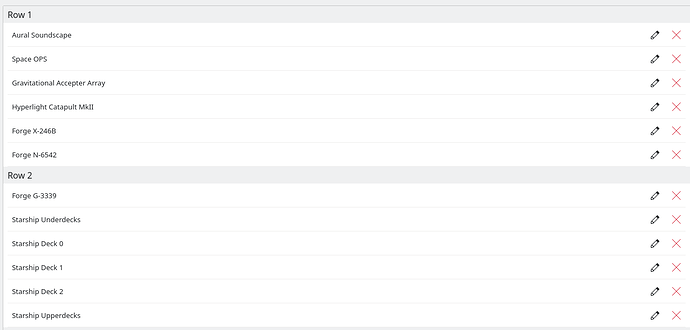I have 18 virtual desktops (I do a lot of things in parallel that I work on gradually as well as having certain desktops reserved for system tasks and hardware monitoring) in 3 rows right now which work pretty well, but I would like to add 3 more (to make a new column), but this appears to be impossible because of a hard coded limit.

Is it possible to get more than 20 virtual desktops? How can I do this?
HW:
System:
Host: MidnightStarSign Kernel: 5.12.0-1-MANJARO x86_64 bits: 64 compiler: gcc
v: 10.2.0 Desktop: KDE Plasma 5.21.4 Distro: Manjaro Linux base: Arch Linux
Machine:
Type: Desktop Mobo: ASUSTeK model: PRIME X570-PRO v: Rev X.0x
serial: <superuser required> UEFI: American Megatrends v: 3001
date: 12/04/2020
CPU:
Info: 16-Core model: AMD Ryzen 9 5950X bits: 64 type: MT MCP arch: Zen 3
rev: 0 cache: L2: 8 MiB
flags: avx avx2 lm nx pae sse sse2 sse3 sse4_1 sse4_2 sse4a ssse3 svm
bogomips: 217685
Speed: 3033 MHz min/max: 2200/3400 MHz boost: enabled Core speeds (MHz):
1: 3033 2: 2506 3: 3735 4: 3742 5: 3780 6: 3733 7: 3740 8: 4671 9: 2899
10: 2885 11: 2594 12: 2491 13: 2514 14: 2527 15: 2565 16: 2639 17: 2559
18: 3739 19: 3733 20: 3730 21: 3753 22: 3822 23: 3734 24: 3409 25: 3734
26: 4672 27: 2509 28: 2540 29: 2373 30: 2459 31: 3748 32: 3750
Graphics:
Device-1: AMD Navi 10 [Radeon RX 5600 OEM/5600 XT / 5700/5700 XT]
vendor: ASRock driver: amdgpu v: kernel bus-ID: 0c:00.0
Device-2: Microdia USB 2.0 Camera type: USB driver: snd-usb-audio,uvcvideo
bus-ID: 7-1:2
Display: x11 server: X.Org 1.20.11 driver: loaded: amdgpu,ati
unloaded: modesetting,radeon resolution: 1: 1920x1080~60Hz 2: 1920x1080~60Hz
3: 1920x1080~60Hz
OpenGL: renderer: AMD Radeon RX 5600 XT (NAVI10 DRM 3.40.0 5.12.0-1-MANJARO
LLVM 11.1.0)
v: 4.6 Mesa 21.0.3 direct render: Yes
Audio:
Device-1: AMD Navi 10 HDMI Audio driver: snd_hda_intel v: kernel
bus-ID: 0c:00.1
Device-2: AMD Starship/Matisse HD Audio vendor: ASUSTeK driver: snd_hda_intel
v: kernel bus-ID: 0f:00.4
Device-3: JMTek LLC. Plugable USB Audio Device type: USB
driver: hid-generic,snd-usb-audio,usbhid bus-ID: 3-1:2
Device-4: Schiit Audio Schiit Modi 3+ type: USB driver: snd-usb-audio
bus-ID: 3-2:3
Device-5: ASUSTek ASUS AI Noise-Cancelling Mic Adapter type: USB
driver: hid-generic,snd-usb-audio,usbhid bus-ID: 5-5:3
Device-6: Microdia USB 2.0 Camera type: USB driver: snd-usb-audio,uvcvideo
bus-ID: 7-1:2
Sound Server-1: ALSA v: k5.12.0-1-MANJARO running: yes
Sound Server-2: JACK v: 0.125.0 running: no
Sound Server-3: PulseAudio v: 14.2 running: yes
Sound Server-4: PipeWire v: 0.3.26 running: yes
Network:
Device-1: Intel I211 Gigabit Network vendor: ASUSTeK driver: igb v: kernel
port: f000 bus-ID: 06:00.0
IF: enp6s0 state: up speed: 1000 Mbps duplex: full mac: 24:4b:fe:5b:08:2a
Bluetooth:
Device-1: Cambridge Silicon Radio Bluetooth Dongle (HCI mode) type: USB
driver: btusb v: 0.8 bus-ID: 3-5.3:6
Report: rfkill ID: hci0 rfk-id: 0 state: up address: see --recommends
Drives:
Local Storage: total: 7.33 TiB used: 3 TiB (40.9%)
ID-1: /dev/nvme0n1 vendor: Western Digital model: WDS100T3X0C-00SJG0
size: 931.51 GiB temp: 49 C
ID-2: /dev/nvme1n1 vendor: Western Digital model: WDS100T2B0C-00PXH0
size: 931.51 GiB temp: 41 C
ID-3: /dev/nvme2n1 vendor: Intel model: SSDPE2KX040T7K size: 3.64 TiB
temp: 32 C
ID-4: /dev/sda vendor: Seagate model: ST2000LM015-2E8174 size: 1.82 TiB
ID-5: /dev/sdb type: USB vendor: Toshiba model: TransMemory size: 14.92 GiB
ID-6: /dev/sdc type: USB vendor: SanDisk model: Gaming Xbox 360 size: 7.48 GiB
ID-7: /dev/sdd type: USB model: N/A size: 29.3 GiB
Partition:
ID-1: / size: 767 GiB used: 704.64 GiB (91.9%) fs: btrfs dev: /dev/dm-0
mapped: luks-466d5812-64c7-4a28-bcc4-a1a5adfa9450
ID-2: /boot/efi size: 511 MiB used: 26.1 MiB (5.1%) fs: vfat
dev: /dev/nvme0n1p1
ID-3: /home size: 767 GiB used: 704.64 GiB (91.9%) fs: btrfs dev: /dev/dm-0
mapped: luks-466d5812-64c7-4a28-bcc4-a1a5adfa9450
Swap:
ID-1: swap-1 type: partition size: 64 GiB used: 8.64 GiB (13.5%)
dev: /dev/dm-1 mapped: luks-81b2dc57-06f5-4471-b484-77c3a516f307
Sensors:
System Temperatures: cpu: 58.0 C mobo: 0 C gpu: amdgpu temp: 48.0 C
Fan Speeds (RPM): N/A gpu: amdgpu fan: 0
Info:
Processes: 934 Uptime: 20h 15m Memory: 62.79 GiB used: 17.82 GiB (28.4%)
Init: systemd Compilers: gcc: 10.2.0 clang: 11.1.0 Packages: 1955 Shell: Bash
v: 5.1.0 inxi: 3.3.04





